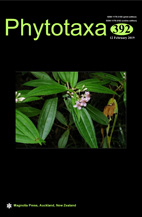Abstract
Cephalocereus parvispinussp. nov. (Cactaceae) from the Mixtecan region (Oaxaca state, Mexico) is described and illustrated. The morphological and molecular evidence support its recognition as a distinct species within the genus Cephalocereus. The new species is characterized by arborescent habit up to 8 m in height, acrotonic branching, stems with 15−23 ribs; flowers 3.5−4 cm long, pericarpel and receptacular tube without podaria nor spines; fruit 1.7−2.2 cm long, dark red, with white flesh; seeds ca. 1.4 ×0.6 mm, dark brown, with a rugose micro-relief. The phylogenetic analysis usingseven cpDNA markers,shows that C. parvispinusis the sister species of C. polylophusand C. euphorbioides.
References
Arias, S., Terrazas, T. & Cameron, K.M. (2003) Phylogenetic Analysis of Pachycereus (Cactaceae, Pachycereeae) based on Chloroplast and Nuclear DNA Sequences. Systematic Botany 28: 547–557.
Arias, S., Terrazas, T., Arreola-Nava, H.J., Vázquez-Sánchez, M. & Cameron, K.M. (2005) Phylogenetic relationships in Peniocereus (Cactaceae) inferred from plastid DNA sequence data. Journal of Plant Research 118: 317–328.
https://doi.org/10.1007/s10265-005-0225-3
Arias, S., Gama-López, S., Guzmán-Cruz, U. & Vázquez-Benítez, B. (2012) Cactaceae. In: Flora del Valle de Tehuacan-Cuicatlan, fascículo 95. Instituto de Biología, Universidad Nacional Autónoma de México. Mexico City, pp. 1–246.
Arroyo-Cosultchi, G., Terrazas, T., Arias, S. & López-Mata, L. (2007) Morfología de la semilla en Neobuxbaumia (Cactaceae). Boletín de la Sociedad Botánica de México 81: 17?25.
Arroyo-Cosultchi, G., Terrazas, T., Arias, S. & López-Mata, L. (2010) Delimitación de Neobuxbaumia mezcalaensis y N. multiareolata (Cactaceae) con base en análisis multivariados. Boletín de la Sociedad Botánica de México 86: 53?64.
Backeberg, C. (1938) Systematische Übersichtsarbeit. Blätter für Kakteenforschung 6: sine pag.
Backeberg, C. (1949) Addenda zu “Blätterfu?rKakteenforschung”. Blätter für Sukkulentenkunde 1: 3.
Backeberg, C. (1950) Nova genera and subgenera. Cactus and Succulent Journal (Los Angeles) 22: 153–154.
Bárcenas-Argüello, M.L., Gutiérrez-Castorena, M.C., Terrazas, T. & López-Mata, L. (2010) Rock–soil preferences of three Cephalocereus (Cactaceae) species of tropical dry forests. Soil Science Society of America Journal 74: 1374–1382.
https://doi.org/10.2136/sssaj2009.0310
Bravo-Hollis, H. (1978) Las cactaceas de Mexico. 2nd ed., vol. 1. Universidad Nacional Autonoma de Mexico, Mexico City, 743 pp.
Britton, N.L. & Rose, J.N. (1909) The genus Cereus and its allies in North America. Contributions from the United States National Herbarium 12: 413–437.
Britton, N.L. & Rose, J.N. (1920) The Cactaceae. Descriptions and illustrations of plants of the cactus family, vol. 2. Carnegie Institute, Washington, 248 pp.
Buxbaum, F. (1961) Die Entwicklungslinien der tribusPachycereae - F. Buxb. Botanische Studien 12: 1?107.
Candolle, A.P. de (1828) Revue de la familia des cactées. Mémoires du Muséum d’Histoire Naturelle 17: 1–471.
Darriba, D., Taboada, G.L., Doallo, R. & Posada, D. (2012) jModelTest 2: more models, new heuristics and parallel computing. Nature Methods 9: 772.
https://doi.org/10.1038/nmeth.2109
Dávila-Aranda, P., Arias, S., Lira-Saade, R.,Villaseñor, J.L. & Valiente-Banuet, A. (2002) Phytogeography of the columnar cacti (tribe Pachycereeae) in Mexico: a cladistic approach. In: Fleming, T.H. & Valiente-Banuet, A. (Eds.) Columnar cacti and their mutualists: evolution, ecology, and conservation. University of Arizona Press, Tucson, pp. 25?41.
Franck, A.R., Cochrane, B.J. & Garey, J.R. (2012) Low-copy nuclear primers and ycf1 primers in Cactaceae. American Journal of Botany 99: e405-7.
https://doi.org/10.3732/ajb.1200128
Hall, T.A. (1999) BioEdit: a user-friendly biological sequence alignment editor and analysis program for Windows 95/98/NT. Nucleic Acids Symposium Series 41: 95–98.
Haworth, A.H. (1819) Supplementum Plantarum Succulentarum. Impresis J. Harding, London, 160 pp.
Haworth, A.H. (1824) Descriptions of some new cacti and Mammillaria, recently brought from Mexico by Mr. Bullock of the Egyptian Hall. Philosophical Magazine and Journal 63: 40–42.
https://doi.org/10.1080/14786442408644461
Hernández-Hernández, T., Hernández, H.M., De-Nova, J.A., Puente, R., Eguiarte, L.E. & Magallón, S. (2011) Phylogenetic relationships and evolution of growth form in Cactaceae (Caryophyllales, Eudicotyledoneae). American Journal of Botany 98: 44–61.
https://doi.org/10.3732/ajb.1000129
Huelsenbeck, J.P. & Ronquist, F. (2001) MrBayes: Bayesian inference of phylogenetic trees. Bioinformatics 17: 754–755.
https://doi.org/10.1093/bioinformatics/17.8.754
Lemaire, A.C. (1839) Cactearum Genera Nova Speciesque Novae. J. Loss, Paris, 115 pp.
Maddison, W.P. & Maddison, D.R. (2017) Mesquite: a modular system for evolutionary analysis. Version 3.2 Available from: http://mesquiteproject.org (accessed 10 January 2019)
Meyer, S.E. (1986) The Ecology of Gypsophile Endemism in the Eastern Mojave Desert. Ecology 67: 1303–1313.
https://doi.org/10.2307/1938686
Pfeiffer, L. (1837) Enumeratio Diagnostica Cactearum. Sumtibus Ludovici Oehmigke, Berolini, 192 pp.
Pfeiffer, L. (1838) UeberLemaire’s Beschreib ungeinigerneuen Cacteen. Allgemeine Gartenzeitung 6: 142.
Plume, O., Straub, S.C.K., Tel-Zur, N., Cisneros, A., Schneider, B. & Doyle, J.J. (2013) Testing a Hypothesis ofIntergenericAllopolyploidy in Vine Cacti (Cactaceae: Hylocereeae). Systematic Botany 38: 737–751.
https://doi.org/10.1600/036364413X670421
Sánchez, D., Arias, S. & Terrazas, T. (2014) Phylogenetic relationships in Echinocereus (Cactaceae, Cactoideae). Systematic Botany 39: 1183–1196.
Sang, T., Crawford, D.J. & Stuessy, T.F. (1997) Chloroplast DNA phylogeny, reticulate evolution, and biogeography of Paeonia (Paeoniaceae). American Journal of Botany 84: 1120–1136.
Schlechtendal, D.F.L. & Chamisso, L.K.A. (1831) Plantarum mexicanarum. Linnaea 6: 352–384.
Schumann, K. (1897–1899) Gesamtbeschreibung der Kakteen. Neudamm, Berlin, 832 pp.
Shaw, J., Lickey, E.B., Schilling, E.E. & Small, R.L. (2007) Comparison of whole chloroplast genome sequences to choose noncoding regions for phylogenetic studies in angiosperms: the tortoise and the hare III. American Journal of Botany 94: 275–288.
https://doi.org/10.3732/ajb.94.3.275
Simmons M.P. & Ochoterena, H. (2000) Gaps as character in sequence-based phylogenetic analyses. Systematic Biology 49: 369–381.
https://doi.org/10.1093/sysbio/49.2.369
Stöver, B.C. & Müller, K.F. (2010) TreeGraph 2: Combining and visualizing evidence from different phylogenetic analyses. BCMBioinformatics 9: 1–9.
https://doi.org/10.1186/1471-2105-11-7
Taberlet, P., Gielly, L., Pautou, G. & Bouvet, J. (1991) Universal primers for amplification of three non-coding regions of chloroplast DNA. Plant Molecular Biology 17: 1105–1109.
https://doi.org/10.1007/BF00037152
Tapia, H.J., Bárcenas-Argüello, M.L., Terrazas, T. & Arias, S. (2017) Phylogeny and circumscription of Cephalocereus (Cactaceae) based on molecular and morphological evidence. Systematic Botany 42: 709?723.
https://doi.org/10.1600/036364417X696546
Tate, J.A. & Simpson, B.B. (2003) Paraphyly of Tarasa (Malvaceae) and Diverse Origins of the Polyploid Species.Systematic Botany 28: 723–737.
Thompson, J.D., Higgins, D.G. & Gibson, T.J. (1994) CLUSTAL W: improving the sensitivity of progressive multiple sequence alignment through sequence weighting, position-specific gap penalties and weight matrix choice. Nucleic Acids Research 22: 4673–4680.
https://doi.org/10.1093/nar/22.22.4673
Vázquez-Sánchez, M., Terrazas, T., Arias, S. & Ochoterena, H. (2013) Molecular phylogeny, origin and taxonomic implications of the tribe Cacteae (Cactaceae). Systematics and Biodiversity 11: 103–116.
https://doi.org/10.1080/14772000.2013.775191

